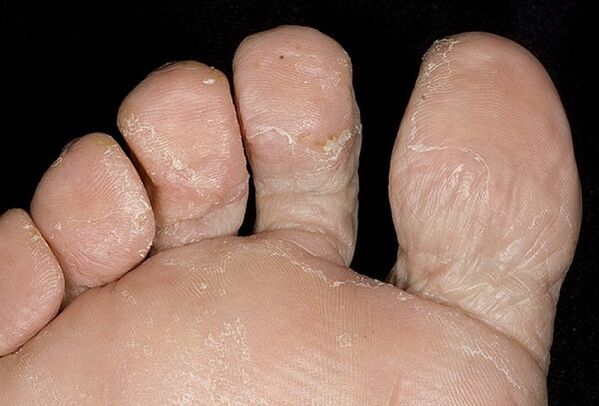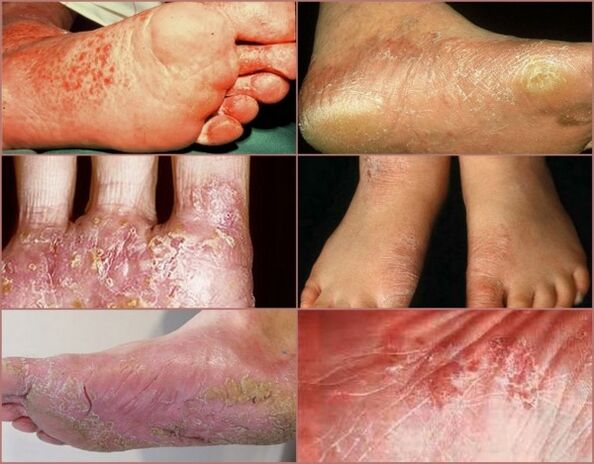The skin fungus in the legs in the photo and in life looks ugly.It creates many problems not only with the appearance, unpleasant smell and constant discomfort, but can cause serious fungal infections that extend far beyond foot.
What are fungi on the legs, fingers and nails in the photo?
The appearance of the fungus is diverse: it depends on the type of pathogen, skin characteristics, the statute of disease limitations, the conditions in which the patient lives, the characteristics of his hygiene regime.The main areas of lesion location are nails, folds between the fingers and the sole.
Affected nails (onychomycosis) generally have an unequal edge of appearance, yellow and unequal, greater fragility, due to which they crumble.Often, the nails become convex, but this also happens unequally.
The intermitted folds are an area where high humidity is almost constantly preserved.They are affected by people who wear uncomfortable or non -corresponding weather shoes.With constant sweat secretion, the reproduction of fungi is activated, and red points appear, which remind the scratches, the crusts of yellowish shovels, blood wounds with a white incursion.
The sole injury is characterized by the peeling of the skin on the entire surface, thickened, in layers.At the same time, inconveniences can occur when walking, increase sweating, which even more stimulates fungus growth.
Types of leg fungi

The mycosis (fungal diseases) of the legs are manifested varied due to the fact that they are caused by several pathogens.Depending on the type of fungus and characteristics of the patient's skin, several types of disease are distinguished.
The item is called Tr.Mentagrophytesvar- An extremely contagious fungus that lives in wet rooms (public bathrooms, swimming pools).A characteristic feature is the peeling and redness of the skin, swelling of the legs, itching and combs, bleeding occurs easily when damaged.
Candidiasis is an infection with a fungus of the Candida genre, which is the most common pathogenic fungus.The defeat of interdigital folds and soles is characteristic.There is severe itching, pain, peeling from the skin.Under exfoliated scales, you can see erosion with a white raid.
Onicycosis is damage to nails, which can have several gravity.The skin injury, less deep than the items, is called Epidermophyia.She is characterized by an unpasted swelling, but remarkable peeled from the skin.
Stages of development
Regardless of the type of pathogen, the fungus takes place in its development several stages:
| The initial stage | The pathology is similar to the stratification of the legs: itching, dry and peeled from the skin, small cracks appear, the swelling is possible. |
| The average stage | Active exfoliation of large layers of the skin, the appearance of several shadow spots, severe swelling, itching and maceration (combs) on the skin. |
| Severe stage | The deep cracks from which blood can be released, abundant exfoliation of the skin, the appearance of deep skin defects and secondary infection spotlights. |
Failure lesions proceed according to a similar scheme: at the beginning, the edge of the nail plate is affected, then gray roads appear throughout the nail, the nail is thick, it becomes fragile, changes color (yellow, white or black).
Symptoms of fungal diseases of the legs
The most striking symptom of fungal foot damage is severe itching.In the early stages of the disease, it is present only when walking or is in an awkward "incomplete" shoes in which sweating is stimulated.Then it becomes constant and very strong.The water or pumice stone procedure can relieve the condition, but its effect is temporary.
The second bright symptom is to peel the skin.It is expressed, sometimes it reaches catastrophic proportions, when large layers of the skin are exfolled.But it can be less pronounced in nature: the constant exfoliation of the scales, which captures a growing area of the foot.
Change the shape of the nails with onychomycosis: the nails become thick and fragile.The layer located under the nails (hyperkeratosis) falls apart when the nails are cut.In some cases, it is possible to loosen the nail in the bed of the nail, in difficult situations: loss.A new nail in its place grows with hyperkeratosis and "roads", irregular form.
The initial stage
The skin fungus in the legs, whose photo can be seen later, is distinguished by gradual development.Therefore, in the early stages, the disease may not manifest in any way.The first signs are quite non -specific: itching during prolonged walk, thickening of the skin, the appearance of peeled scales in plants.The fungus of the nails is not manifested for longer than a fungus of the skin.
Some signs by which you can suspect the fungus:
- The condition of the skin worsened after the pool, the sauna, the gym or any other place with high humidity and a large number of visitors;
- Itching intensifies in a humid environment;
- Skin pigmentation has changed: spots appeared;
- Pelado occurs unequally along the entire foot, concentrating more in the area between the fingers and in the sole;
- Similar symptoms are observed simultaneously among several people who visited places of possible infections or live in the same apartment.
Interdalz form
This form is the most unpleasant for the patient.The main location of the lesions is the folds between the fingers, more often 3 and 4 of the finger suffer, less frequently, the fold between 1 and 2. This is associated with the characteristics of the sole structure.For the fungus, high temperature and humidity conditions are optimal, while minimum air exposure or mechanical factors that can eliminate the fungus.
These are those conditions that are created in the fold between 3 and 3 fingers, the least mobile of all.
Characteristic symptoms: itching and burning in the place of injury, the appearance of the skin of the lesions that resemble friction, with the progression of the disease, become inflammatory ulcers covered with white coating.Touching them is extremely painful, the symptoms of the disease improve in warm climate, in uncomfortable shoes and with an increase in moisture.
How the escamoso-hydkerototic scenario manifests
This stage is characteristic of diseases that affect the only one.Its most vivid symptoms are expressed skin peeling, its excessive keratinization.The plants look rude, the sensitivity of the skin decreases, touching it becomes unpleasant.The scales are exfoliated by large layers, or vice versa, their separation occurs with difficulty, while the skin is possible.
On the feet affected by the fungus, calluses, calluses and other pathological phenomena arise more easily.Walking becomes uncomfortable, during a long -term stay in the shoes, the itching and leg pain intensify.

Dihydrotic stage
It is characterized by a change of sweating.None of the types of fungi can be established in the sweat gland, but indirectly, affecting the epidermis, the inflammatory process interrupts sweating.
The peculiarity in this way is the formation of large blisters in the skin, which easily merger with each other.Most of the time, the disease begins with a form of inter backball and acquires a severe course as progress.
The second characteristic feature is abundant sweating and unpleasant smell of the legs.In plants there are apocrine sweat glands (which distinguish thick sweat), this explains the most acute than in open areas, the smell even in healthy people.Due to the fungus, sweating increases, therefore, the smell increases.
Diagnosis of leg fungus
The fungus of the skin in the legs, whose photo will be given below, has external manifestations characteristic, so the dermatologist begins the diagnostic process when examining the affected limb.This procedure must be carried out exclusively in gloves, since for the doctor there is a great risk of infected with the patient.
The information received during the inspection clarifies the history of anamnesis: a visit to places where the fungus, with the shoes of another person or living in the same apartment with a sick person can live.
For a more precise diagnosis, a microbiological examination is carried out: a small fragment of the skin, the nail or separated from the bubbles in a sterile container is collected and then examined under a microscope.Such analysis has been, therefore, is carried out to confirm or adjust the treatment regime, or in cases where the appearance of the fungus raises doubts.
Effective treatment methods
The main task of treatment is to eliminate the pathogen.To do this, several products are used that apply to affected skin or are taken inside.The treatment is mandatory so that all family members exclude infection.
For the same purpose, the patient must get used to complying with the rules of personal hygiene and caution when visiting public places where he can infect with a fungus.
In therapy, the fungus should not use antibiotics in any case: these medications cause the death of bacteria and release the vital space for fungi, which aggravate the patient's condition.But the products give a good effect that increase immunity, since the fungus is part of a microflora of normal skin.
Good and economical pharmaceuticals ointments
The skin fungus in the legs is treated in an integral way.The main thing to do is eliminate the pathogen.
For this, antifungal ointments are used: they are applied directly to the skin and affect the affected area of the foot.In addition, they do not cause systemic side effects, that is, they are not absorbed in the blood.
The ointment applies to the skin after washing the legs, the amount of application 3-8 per day, depending on the intensity of the process and the type of ointment.The tool does not need to be washed, but it should be allowed to absorb (5-10 minutes) before putting socks and shoes.
To combat nail fungus, there are medicinal varnishes.They are colorless and do not have a smell.The varnish covers the nails with a layer of a medicinal substance that is maintained for a day, it is not washed with water, it is not washed and does not require update during the day.This allows people who have an adjusted work schedule, or those who are sick of vacations.
To improve the effect of antifungal ointments, it is recommended to treat skin with local antiseptics: miramistine, boron alcohol solutions and salicylic acid, hydrogen peroxide, chlorhexidine.
Preparations for internal use
The use of medications for oral administration is indicated in cases where the disease has acquired a serious course, an extensive distribution or the patient cannot treat legs with antimicotic agents with sufficient frequency.In addition, drugs can be prescribed to strengthen immunity.
The skin fungus in the legs, which occurs in the photo beyond the article, is treated with antimicotic pills.They are used in combination with ointments or as an independent tool.What tool is shown in this case, the doctor decides.
With the development of fungus complications, hospitalization and the introduction of the same medications intravenously may be required.
In complex therapy, anti -inflammatory tablets, medications to increase immunity and other medications at the specialist discretion can be prescribed.The purpose of its purpose is to increase body resistance to pathogenic influences and improve the effectiveness of antifungal treatment.
Popular fungus remedies
Popular remedies for the fight against fungi are also based on an anti -inflammatory and disinfectant effect.For the most part, these are feet baths based on various medicinal rates.Its effectiveness is less than pharmaceutical drugs, but allows you to improve patient's health.Before using them, it is advisable to consult a doctor not to reduce the general effectiveness of the treatment.

The skin fungus on the legs (the photo next shows how unattractive the problem is seen, if not treated), it is successfully eliminated by bathrooms with celnicin or calendula.To do this, the raw materials of the plant are insisted on boiling water, the resulting mixture is filtered and dissolved in warm water.The bathroom temperature should be such that the patient is comfortable to lower the legs in it.
As additional components, you can add chamomile, burdock, banana and worm.
There are also recommendations to use washing dust (any) as the main therapeutic component of the bathroom, lubricate the areas affected with BF glue, as well as iodine or vinegar.It should be remembered that popular recipes require caution in circulation so that health is not harmful.
Prevention
To avoid infection with a fungus, several simple rules must be observed:
- Observe personal hygiene rules: legs must be clean and dry, for dry skin you need to use the cream;
- Use comfortable socks and shoes corresponding to the weather, choose "breathing" materials that create comfortable skin conditions;
- When visiting swimming pools, public bathrooms and other places where you can infect with a fungus, use pool shoes and after returning home to wash your legs;
- Use only your hygienic accessories: towels, pedicure scissors;
- If the fungus is detected, the whole family must be treated, regardless of whether the symptoms have appeared.
A good result provides hardening and other procedures that strengthen the immune system.This prevents the development of fungal infection during infection.It is important to monitor nutrition: the reception of a sufficient amount of proteins and vitamins supports immunity, and excess sweets can stimulate fungal growth.
The photos of the skin fungus in the legs are seen repulsive, but this disease is curable with the right approach.It can be cured quite fast (within 1-2 weeks).If complications have not been developed, then the patient can undergo a treatment course without interrupting work and rest.Hospitalization is only required in the most serious and advanced cases in patients with immunity disorders.
















